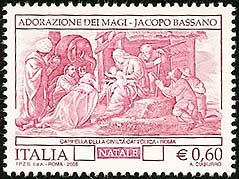
ITALY, the Christmas issue of 2006 shows Jacopo Bassano's Adoration of the Magi,
which is, as indicated on the stamp, in the chapel of the Jesuit publication, La Civiltá Cattolica, Scott 2778
IN
OUR HOUSES |
Adoration of the Magi by Bassano

ITALY, the Christmas issue of 2006 shows Jacopo Bassano's Adoration
of the Magi,
which is, as indicated on the stamp, in the chapel of the Jesuit publication, La
Civiltá Cattolica, Scott 2778
The Archangel St. Gabriel by della Valle
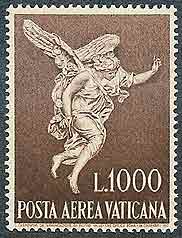

VATICAN CITY, 1962, Scott C45-C46
The Archangel St. Gabriel was sculpted by Philip della Valle for
the large Annunciation group atop the tomb of St.
John Berchmans in the Jesuit Church of St. Ignatius in Rome.
The Circumcision of Christ by Rubens
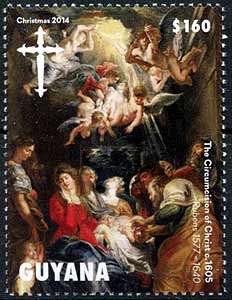
GUYANA, 2014, the Christmas issue includes Rubens' The Circumcision
of Christ now in the Chiesa del Gesù in Genoa, Italy, Scott 4368
Chiesa del Gesù, (its full name is Chiesa del Gesù e dei Santi Ambrogio e Andrea) is masterpiece of Baroque style and probably the most beautiful church in whole of Genova. The first church on this site was erected in the 6th century, a time when this site became home for refugees from Milano during the Lombards' invasion. Bishop Ambrose, who later on become the patron saint of Milan, built the first church here. When the old church was demolished the Jesuits built their church on the same site in the 16th century, designed by Pellegrino Tibaldi.
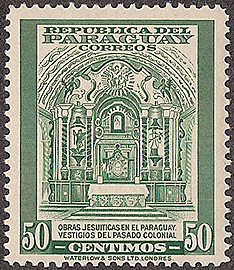
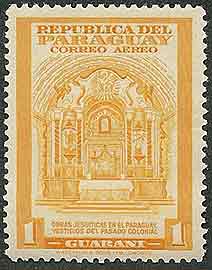
PARAGUAY, 1946, Jesuit Works in Paraguay issue, Scott 440, C143
While this section is about things in Jesuit churches or houses, this altar is not in a Jesuit church. The stamp honors "obras Jesuiticas" and Scott describes this as a "Colonial Jesuit Altar." So one might presume this is a Jesuit church — surely that is St. Francis Xavier in the niche on the right. It is, however, the church of Capiata, which is near Jesuit ruins, but it is not supposed to have belonged to the Society. A local tradition ascribes the altar though to a certain Master Gabriel, who was a student of the Jesuits.
A Gilded Carving of Angel
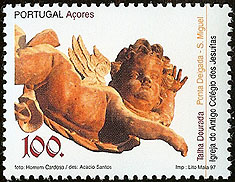
PORTUGAL (Azores), 1997, Scott 444
This gilded carving of an angel is from the church of the ancient Jesuit college in Porta Delgada, on São Miguel in the Azores.
The Antipolo Virgin
SPAIN, 1965, 4th centenary of the Evangelization of the Philippines, Scott 1331
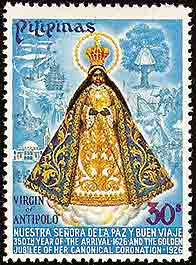
PHILIPPINES, 1976, 350th anniversary of the arrival of the statue of the Virgin of Antipolo, Scott 1303-1304On March 25, 1626, Governor Juan Niño de Tabora sailed from Mexico for the Philippines, bringing with him an image of the Blessed Virgin. For three months his galleon, El Almirante, endured storms and even fire. He attributed his safe arrival in Manila to the presence of the image, and called for a celebration in her honor. The procession went from the Church of San Ignacio, the Jesuit church in Intramuros, to the Manila cathedral. At the governor's death in 1632, the image was turned over to the Jesuits for the church they were building in Antipolo. The Franciscans were the first founders of Antipolo; the Jesuits received it from them and administered the mission until 1768. Fr. Juan de Salazar, SJ had a stone church built from 1630 to 1633 specifically to receive the statue of Nuestra Señora de la Paz y Buenviaje (Our Lady of Peace and Good Voyage), patroness of the galleons. The statue eventually crossed the Pacific, and returned, eight times on the galleons of Acapulco. At each return to the Philippines it was met by the captain general and the archbishop of Manila and escorted back to the Antipolo church, her original and permanent sanctuary. A royal decree of 1864 changed the assignment of churches and Antipolo was given to the Augustinian Recollects.
Consolatrix Afflictorum
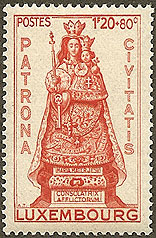
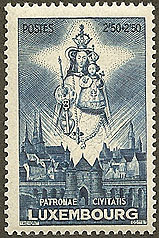
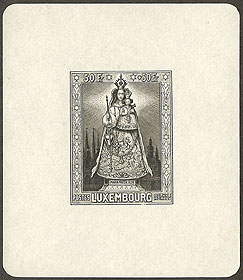
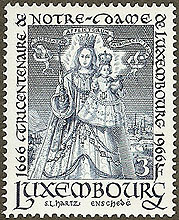
LUXEMBOURG, 1945, a semi-postal issue to help restore the cathedral after
the war.
Our Lady of Luxembourg, Consolatrix Afflictorum and Patroness of the City,
is seen on Scott B122-3, and on the set's souvenir sheet , Scott B126.
She also appears in a 1966 third centenary set, Scott 438
Below, the statue is carried in procession and above the main altar, Scott B121,
125
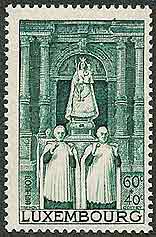
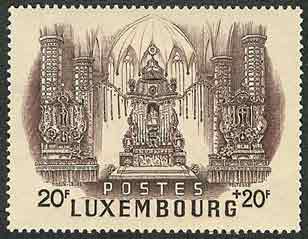
An important part of Luxembourg devotion is veneration of the image of Mary, Consolatrix Afflictorum (Comforter of the Afflicted) in the Cathedral of Luxembourg. The initiator of this devotion was a Jesuit priest, Father Jacques Brocquart († 1660). He was at the Jesuit college of Luxembourg, founded in 1603. Fr. Brocquart had been cured through the intercession of Mary and in honor of her on the feast of the Immaculate Conception, December 8, 1624, led a procession of students in the local Sodality outside the walls of the city on the Glacis field. The statue was carried in that procession. Soon a chapel was built on the site and pilgrims began to come. By 1639 a book had been published detailing miraculous cures that had taken place at the shrine. An annual octave of prayer was begun and so many pilgrims came that during that time the statue was temporarily moved to the main collegiate church (now the cathedral). After the Suppression the statue, chapel and church were transferred to the local diocese, and in 1794, the statue was moved from the original shrine chapel and permanently placed above the main altar of the old Jesuit church. The church has been the cathedral of the Luxembourg diocese since 1870.
LUXEMBOURG, 2016 a joint issue with the Vatican (below) marking the 350th anniversary of the election
of Mary, Consolatrix Afflictorum, as the patroness of the city of Luxembourg.
The cathedral altar is at the center of the sheet and the cathedral to the left of the stamps.
FDI cancel from Luxembourg
VATICAN CITY, 2016 a joint issue with Luxembourg (above) marking the 350th anniversary of the election
of Mary, Consolatrix Afflictorum, as the patroness of the city of Luxembourg.
The cathedral altar is at the center of the sheet and the cathedral to the left of the stamps.
VATICAN CITY, 2016, special FDI cancel for the above stamp.
Immaculate Conception by de Juanes
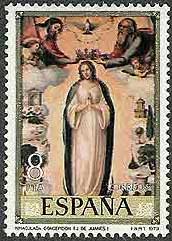
SPAIN, 1979, painting by Juan de Juanes, Immaculate Conception,
Scott 2164
The Immaculate Conception was painted for the Jesuit church of Valencia where it is still honored. It is considered the best work of Juan de Juanes. The Jesuit who commissioned the painting forced de Juanes to make many corrections to allow into the background invocations from the Litany of Loretto.
Immaculate Conception by Obici

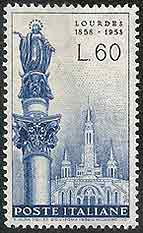
ITALY, 1958, the Lourdes centennial, Scott 739-740
This set features a composite picture of the statue of the Immaculate Conception which crowns the Colonna dell'Immacolata in the Piazza di Spagna (Spanish Steps) at the heart of Rome's shopping district, and the basilica of Lourdes in the south of France. The original cast for the statue, made by the artist Joseph Obici, is to be found in a chapel of the Istituto Massimo, a Jesuit college in Rome. In one of the more cherished rites of Rome's calendar, each December 8th the Pope comes to the Piazza di Spagna to pay homage to this figure of the Immaculate Conception.
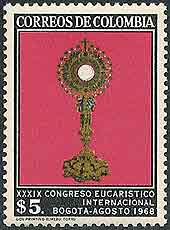
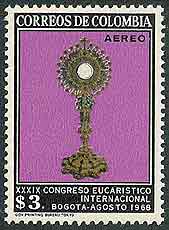
COLOMBIA, 1968, the 39th Eucharistic Congress, Scott 780, C505
This monstrance, the work of Joseph de Galaz, is at the College of St. Bartholomew. The artist spent seven years at the task and the monstrance was blessed on the feast of St. Ignatius, July 31, 1707. Besides other precious stones, 1,485 emeralds are embedded in the gold. The people have dubbed it by the affectionate if inelegant name of La Lechuga (The Lettuce).


COLOMBIA, 1968, the 39th Eucharistic Congress, Scott 781a
1970, Philatelic Week, including the $5 monstrance stamp, Scott 791
(above the an in semana)
Madonna della Strada
SPAIN, 1983, special anniversary cancel for the Foundation of Our Lady della Strada, Barcelona
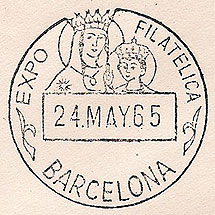
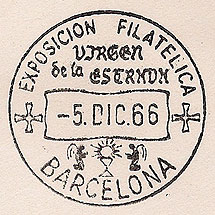

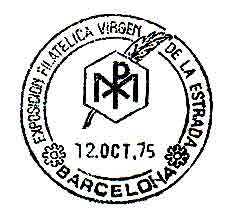
SPAIN, 1965-75, show cancels honoring the Virgin della Strada
After approving the Jesuits in 1540, Paul III gave Ignatius and his companions their first church, the church of Santa Maria Della Strada, which housed an icon, "the Madonna della Strada," a favorite of Ignatius and his followers. Twenty years later Cardinal Alessandro Farnese built the Gesù, the Jesuits' mother church in Rome, to replace the smaller church and the icon was moved to a chapel with the larger building. There are also references to Our Lady della Strada in the CLC cancels.
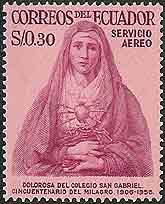
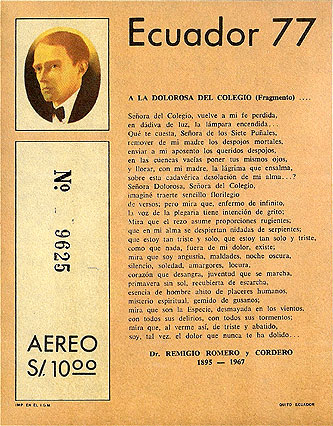
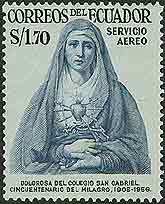
ECUADOR, 1958, the
50th anniversary of the miracle of Saint Gabriel's College, Scott
C320, C323
1977, honoring the poet Remigio Romero y Cordero with
part of his A la Dolorosa del Colegio, Scott C612A
The image of Our Lady of Sorrows is kept in the Jesuit Saint Gabriel College. The official page accompanying the release of the 1988 stamps tells the story: "San Gabriel College was on the point of disappearing completely. But in 1906 — at the height of the anticlerical period — came the miracle of April 20, when a picture of Our Lady of Sorrows to the wonder first of Quito and then of the entire country, opened and closed its eyes for more than twenty minutes before the amazed gaze of forty students of the college who are witnesses to the prodigy. From that time on, the history of the College of San Gabriel began to be written with a new start . . ."
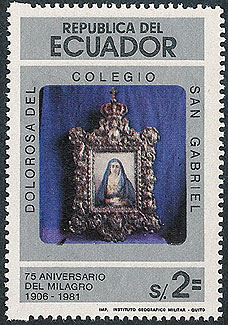
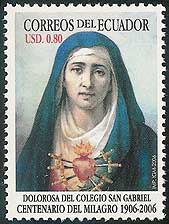
ECUADOR, 1981, the 75th anniversary
of the miracle, Scott 1015
ECUADOR, 2006, the 100th anniversary of the miracle,
Scott 1779


ECUADOR, 1988,
the 125th anniversary of the miracle, Scott, 1171-72
Matka Boza Kochawinska

POLAND, 2014 Our Lady of Kochawin, Scott 4131
The veneration of Our Lady of Kochawin (a village originally in Ukraine) began with the erection of a small wooden chapel in 1680 and the pilgrimages that began in that year. It was first cared for by the Carmelite fathers but has been taken care of by the Jesuits since 1931. War and persecution caused the image to be relocated several times, and even for a time kept from public view. It was placed in 1967 in the Jesuit provincial's residence in Krakow, on November 4, 1972 was transferred to the church of St. Barbara, on March 21, 1974 was transported to Gliwice, to the parish of St. Bartholomew, and finally in 1994 was enshrined in a new church dedicated to Our Lady of Kochawin also in Gliwice.

FRANCE, 1941, the coat of arms of Montpelier, Scott B127
Notre Dame des Tables is patroness of the town of Montpelier in France. In 1143 Guillem VI, Lord of Montpellier, brought a miraculous statue back from Holy Land. It was set up in a church called Our Lady of the Tables to distinguish it from Our Lady of the Castle, because the merchants had their tables near the former. The statue became the center of pilgrimage. The Church of Notre Dame Des Tables disappeared after the Revolution; but the cult transferred to the chapel of the Jesuits and is still in vogue. Her image is on the coat of arms of Montpelier.
Our Lady of the Rosary of Candonga

ARGENTINA, 2005, the chapel and statue of Our Lady of the Rosary
of Candonga, Scott 2341
In a painted wooden niche of the Jesuit Candonga Chapel, illuminated by natural light though the small cupola of the chapel, is preserved and venerated this statue of Our Lady of the Rosary. Carved of wood and painted by local artists, it as well as the chapel dates from about 1750.
The Taking of Christ by Caravaggio
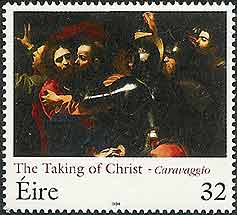
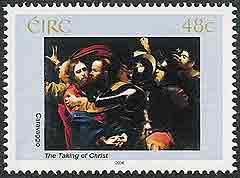
IRELAND, 1994 and 2004, Scott 920 and 1575
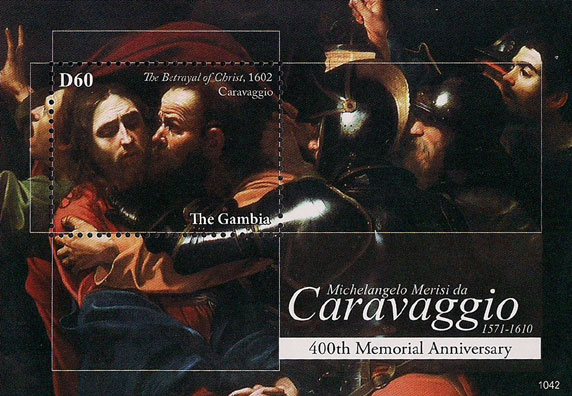
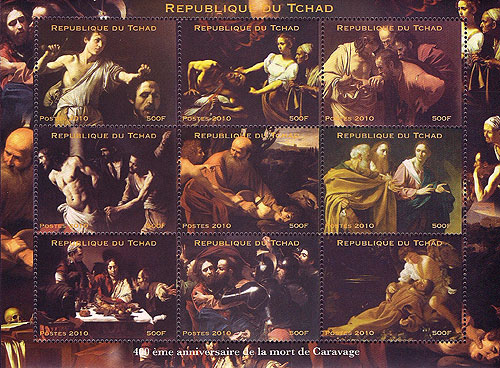
GAMBIA, 2010, the 400th anniversary of Caravaggio's death, Scott 3329
CHAD, 2010, the 400th anniversary of Caravaggio's death (center bottom
stamp & selvage); this sheet also exists imperf.
The Taking of Christ hung from 1960 to 1991 on the wall of the Jesuit community on Leeson Street in Dublin, Ireland. It was the gift of a benefactor and, presumed to have been done by von Honthorst, was given an honorable place for most of those years in the dining room. When the superior of the community, Fr. Noel Barber, SJ, decided to have the painting cleaned and approached the National Gallery of Ireland, the truth came out. It was a Caravaggio, painted in 1602, but long lost and worth not a small fortune. It is consequently no longer in the Jesuit house, but on loan to the National Gallery of Ireland. The Jesuits of Leeson Street, by the way, produce Sacred Space, a deservedly popular prayer place on the Web and well worth a visit.

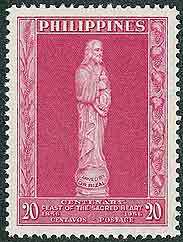
THE PHILIPPINES,1956, the Second National Eucharistic Congress and the
100th anniversary of the Feast of the Sacred Heart, Scott 632-33
When Jose Rizal, the hero of the Philippines, was thirteen years old he carved this 22-inch-high statue of The Sacred Heart. The statue was preserved in the Ateneo de Manila and escaped destruction when very little else did in the fire of 13 August 1932. It is still treasured at the Ateneo.
The Urn of St. Mary Anne de Paredes
ECUADOR, 1946, Scott 474In the sanctuary of the Jesuit church in Quito, Ecuador is this silver urn with the remains of St. Mary Ann de Paredes (1618-1645).